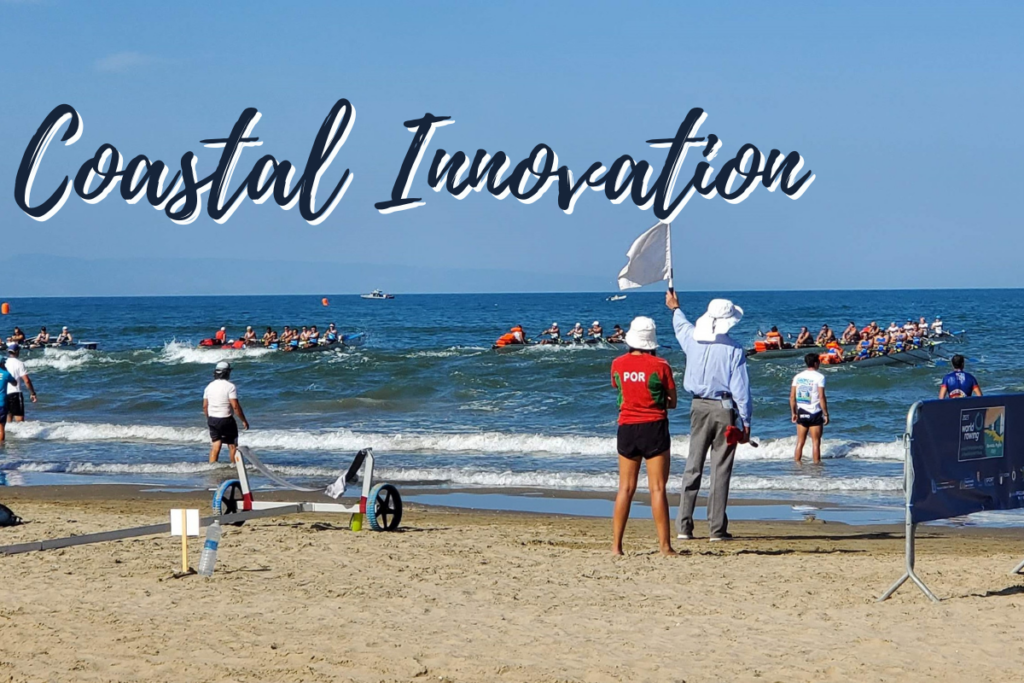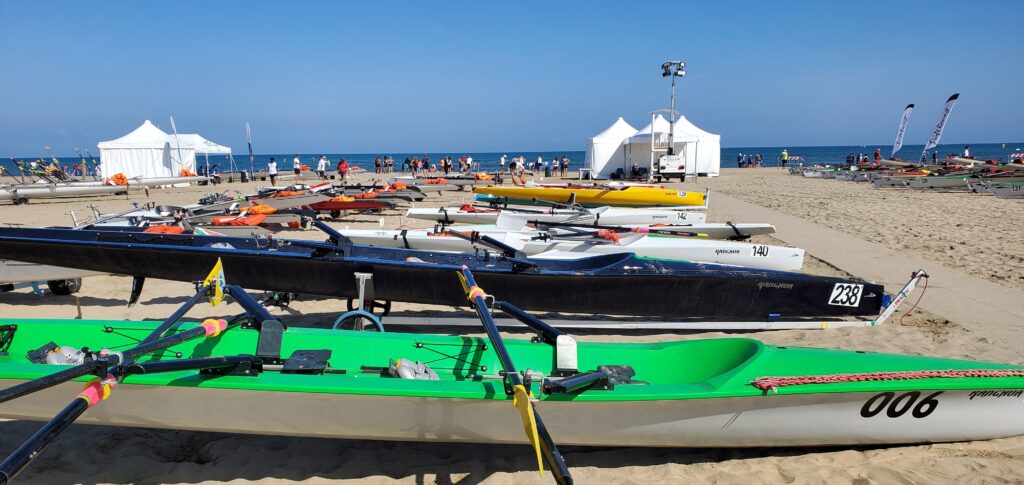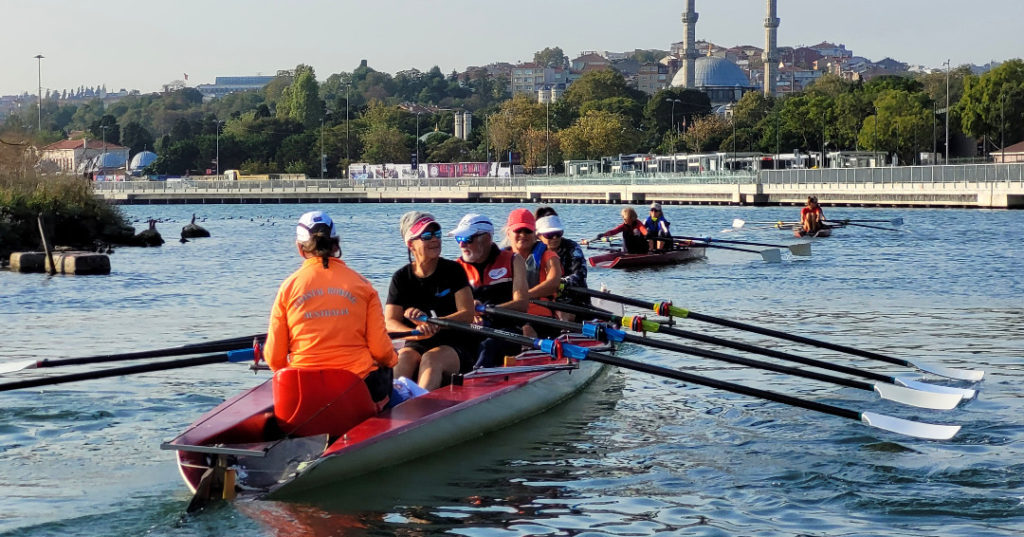
Coastal Innovation
This post was originally commissioned and paid for by NK Sports in 2024.
Coastal rowing is making a bigger splash in the world of rowing. With the inclusion of Beach Sprints in the 2028 Los Angeles Olympics, athletes, national federations, rowing clubs and rowers of all types are catching the coastal wave. A comparatively new sport, built on a long tradition of open water rowing, the story of coastal rowing is a story of innovation and imagination.
Humans have been rowing on salt water or large bodies of freshwater for millenniums. Egyptians are credited with coastal rowing innovation as early as 1900 BC. Slaves rowed Greek and Roman galleys to battle, Vikings crossed oceans rowing their long boats, church boats ferried Finnish families to Sunday worship, dories were rowed out to fish the Grand Banks for cod. An early example of coastal racing are Cornish pilot gigs. In the age of sailing vessels, gigs would race out to meet ships arriving on the Cornwall coast to offer pilot services into safe harbour. The boats also raced for rescue operations or salvage opportunities.
A quick history of coastal racing and Beach Sprints
Credit for the first sliding seat coastal boats goes to either Alden Open Water in the USA in the 1970s or a group of French naval architects and innovators in the 1980s. Racing soon followed in France, then Italy and other European countries. World Rowing embraced the sport, holding the first World Rowing Coastal Championships (WRCC) in Cannes in 2007. This is the endurance version of coastal racing. The distance raced is between 4 and 8 km, following a buoyed course with some massive turns. The contestants might start from the beach and/or end on the beach with a race on the sand to the finish line. As many as 16 boats line up for the start of each race, making for clashes at the turns. Navigational skills are necessary especially for the singles and doubles events, as well as ability to row with waves, swells and currents.
Guin Batten, current chair of the World Rowing Coastal Commission, spearheaded the emergence of the Beach Sprint format, shepherding it towards its upcoming Olympic debut. In 2011 the WRCC were held in Bari, Italy. Guin had just become Chair of the Rowing for All Commission of World Rowing, which at the time included coastal rowing. Together with Pasquale Triggiani, chair of the Organising Committee, Guin innovated a fun race day after the Championships were completed, with racing beginning from the beach. Spectators loved seeing the action close up, and the idea of Beach Sprint took hold. Beach games were emerging. The first World Rowing sanctioned Beach Sprints took place in 2015 at the Mediterranean Beach Games in Pescara, Italy. Beach sprints were a huge success at the 2016 Asian Beach Games, in Da Nang, Vietnam. The sport took off in 2018, with more international events and national federations such as British Rowing embracing Beach Sprints.
In October 2018, the 2022 Youth Olympic Games were awarded to Dakar, and if rowing was to be included it needed to be on the sea, so Beach Sprint Rowing was put forward to the IOC and accepted. The games were postponed until 2026 due to the Covid-19 pandemic.
Following this decision, World Rowing realised that it was time to establish the World Rowing Beach Sprints Finals. The Rowing for All Commission wanted to ensure the format maintained its low cost and complexity, so called it a ‘Finals’ rather than a ‘Championships’, to try and stop the regatta getting bigger and bigger.
World Rowing 2023 How Beach Sprints Came to Be
The first World Rowing Beach Sprint Finals were held the following year in Shenzen, China. After the pandemic hiatus, the Finals and WRCC have grown steadily. The number of countries participating, including some without coats, is increasing along with the caliber of the racing, with more Olympians taking up the sport. Coastal rowing is facilitating the emergence of rowing in nations with little or no flatwater, especially the island nations of the Caribbean and Oceana, such as Barbados and Vanuatu. Para rowing has been part of the Beach Sprints Finals since 2023 with the PR3 mixed double.

New coastal boats and oars
A sure sign that something is really happening is when businesses start investing and innovating. It is expensive and risky to design a boat, go into production and bring it to market. Yet there is an uptick in the number of boat builders in the coastal game plus innovation in design and construction methods.
Filippi, famous for its Olympic class racing shells, has been building coastal boats for decades, beginning with a hand built wooden “canoe” that was rowed across the English Channel in the 1980’s. Beginning in 2023, Filippi introduced a special beach sprint model, with a different design from the models raced in the endurance events. Hudson Boatworks, is also a prestigious manufacturer with many Olympic and World Rowing medals won in its Olympic class flatwater boats. It has come later to coastal boat building, launching its Coastal SHARK 1X with a slightly different bow design.
Coastal boats used to be primarily built in France or Italy and more recently China. Specialized coastal boat manufacturers are now found in Portugal (Ave), Sweden (Leo) and Spain (Rubinetti). Swift is apparently starting to build coastal boats in Turkey. Kanghua of China entered the coastal rowing boat market in 2021 and are experimenting with autoclave technology which will allow them to manufacture lighter but stronger boats.
Coastal boats are now being built in the USA by NEXT Boatworks. Ben Booth of the company is legendary. He has been called the Zen master of coastal chaos. Perhaps best known for his remarkable videos and photos of rowing through surf and freezing water, Ben loves all aspects of coastal rowing, whether beach sprints, endurance coastal racing or rowing touring in coastal boats. NEXT Boatworks has a clear mandate of making coastal rowing, and so rowing generally, more widely accessible.
The original concept of a “rowing for all” boat perhaps belongs to LiteBoat, manufactured in France. They innovated stable and light boats. They have models which are raced and win medals at coastal regattas but the larger market is rowers who do not compete. There is not a race for their Trio which can be rowed with three rowers or as a coxed double. The latter is popular in the Netherlands for rowing marathons or clubs use them for learn to rows. Then there is the rowing shell which you can also sail.
Concept2 has been working on oars for coastal rowing for several years. Oars need to be light yet also strong and agile to handle sharp buoy turns, beach landings, boat clashes, and surf capsizes. The company successfully conducted a large-scale trial of their redesigned coastal shaft at the 2022 World Rowing Coastal Championships and Beach Sprint Finals held in Wales. Ben Booth also provided extensive testing and feedback across the range of coastal rowing. While Concept2 is the leader in coastal oars, other manufacturers are introducing products specific for coastal conditions.
Coastal innovation yet to come
What drives innovation? Building a better mousetrap is one motivation – do something better than what already exists. Creating something completely new and different – the “blue ocean” strategy without competitors – is another. Solving a challenge, finding a solution to a problem is perhaps the most significant force driving innovation.
In coastal racing, whether beach sprints or the endurance form, one problem are feet. Coastal boats tend to have two means of connecting rowers to their boat: shoes, usually plastic and with many straps or the ergometer style of straps on the foot stretcher. At the start of both endurance and sprint races, at least one and sometimes all rowers must enter the boat after the starting gun fires. Speed in settling in and starting to row is essential. In the short Beach Sprints there is especially no time for error. Is there a better shoe or foot strap that facilitates fast entry and exit but solid connection to the boat?
NK Sports is also taking note of coastal rowing. Athletes train and race using the SpeedCoach GPS 2, just as they might for flatwater rowing. Data on stroke rates, splits and distance rowed is helpful for the athletes to pace themselves over the 4 or 6 km course of the endurance style of racing. Another major aspect to potentially winning is being able to navigate the course effectively, aiming for buoys often more than 1 km away and adapting to the impact of winds and currents, all while responding to the tactics and progress of other competitors. Michael Naughton, COO at Nielsen-Kellerman, points out that the SpeedCoach GPS 2 has an integrated GPS module, so it’s technically viable to develop navigational assistance if there’s demonstrated demand from the market. Another innovative use of NK’s SpeedCoach and LiNK Logbook app could be to combine the real-time performance data with video from boats and drones. Spectators on the beach at the WRCC would be able to see video paired with performance similar to an F1 or NASCAR race. Innovation is adding to the growing excitement of coastal rowing.
I regularly write about coastal rowing – do a search on this website for the topic and you will find posts beginning in 2014. Every few years I offer an update. I am looking forward to what I will be writing about in a few years about coastal innovation.
